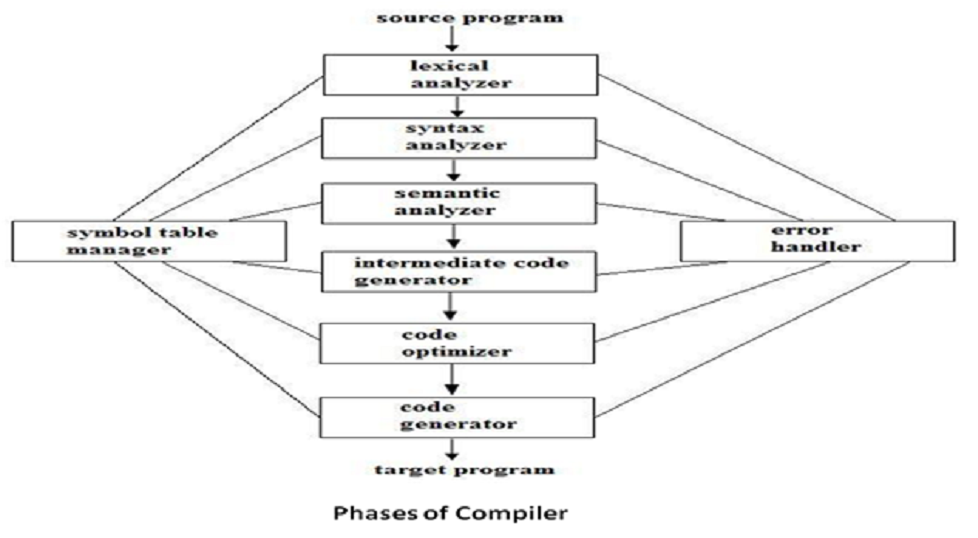Phases of Compiler:

Compiler operates in phases.
• Each phase transforms the source program from one representation to another.
• Six phases:
– Lexical Analyser
– Syntax Analyser
– Semantic Analyser
– Intermediate code generation
– Code optimization
– Code Generation
• Symbol table and error handling interact with the six phases.
• Some of the phases may be grouped together.
These phases are illustrated by considering the following statement:
position := initial + rate * 60

Symbol Table Management:
– Symbol table is a data structure containing a record for each identifier, with fields for the attributes of the identifier.
– Record the identifier used in the source program and collect information about the identifier such as,
• its type, (by semantic and intermediate code)
• its scope, (by semantic and intermediate code)
• storage allocation, (by code generation)
• number of arguments and its type for procedure, the type returned
• Error Detecting and Reporting:
– Each phase encounters errors.
– Lexical phase determine the input that do not form token.
– Syntax phase determine the token that violates the syntax rule.
– Semantic phase detects the constructs that have no meaning to operand.
• The Analysis Phase:
– Involves: Lexical, Syntax and Semantic phase
– As translation progresses, the compiler’s internal representation of the source program changes.
• Lexical Analysis Phase:
– The lexical phase reads the characters in the source program and groups them into a stream of tokens in which each token represents a logically cohesive sequence of characters, such as, An identifier, A keyword, A punctuation character.
– The character sequence forming a token is called the lexeme for the token.
• Syntax Analysis Phase:
– Syntax analysis imposes a hierarchical structure on the token stream. This hierarchical structure is called syntax tree.
– A syntax tree has an interior node is a record with a field for the operator and two fields containing pointers to the records for the left and right children.
– A leaf is a record with two or more fields, one to identify the token at the leaf, and the other to record information about the token.
• Semantic Analysis Phase:
– This phase checks the source program for semantic errors and gathers type information for the subsequent code-generation phase.
– It uses the hierarchical structure determined by the syntax-analysis phase to identify the operators and operands of expressions and statements.
– An important component of semantic analysis is type checking.
• Intermediate Code Generation:
– The syntax and semantic analysis generate a explicit intermediate representation of the source program.
– The intermediate representation should have two important properties:
• It should be easy to produce,
• And easy to translate into target program.
– Intermediate representation can have a variety of forms.
– One of the forms is: three address code; which is like the assembly language for a machine in which every location can act like a register.
– Three address code consists of a sequence of instructions, each of which has at most three operands.
• Code Optimization:
– Code optimization phase attempts to improve the intermediate code, so that faster-running machine code will result.
• Code Generation:
– The final phase of the compiler is the generation of target code, consisting normally of relocatable machine code or assembly code.
– Memory locations are selected for each of the variables used by the program.
– Then, the each intermediate instruction is translated into a sequence of machine instructions that perform the same task.
Token: Token is a sequence of characters that can be treated as a single logical entity. Typical tokens are, 1) Identifiers 2) keywords 3) operators 4) special symbols 5) constants
Pattern: A set of strings in the input for which the same token is produced as output. This set of strings is described by a rule called a pattern associated with the token.
Lexeme: A lexeme is a sequence of characters in the source program that is matched by the pattern for a token.
|
Example: Token |
lexeme |
pattern |
|
const |
const |
const |
|
if |
if |
if |
|
relation |
<,<=,= ,< >,>=,> |
< or <= or = or < > or >= or letter followed by letters & digit |
|
i |
pi |
any numeric constant |
|
nun |
3.14 |
any character b/w “and “except" |
|
literal |
"core" |
pattern |
A pattern is a rule describing the set of lexemes that can represent a particular token in source program.
